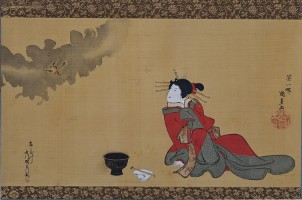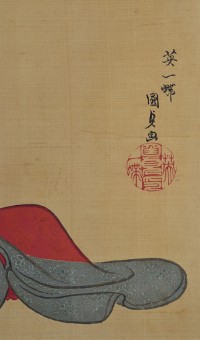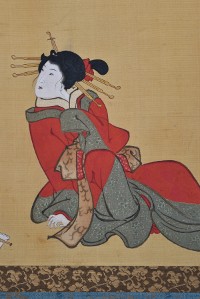Utagawa KUNIYOSHI (1797-1861)
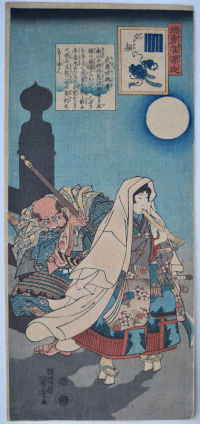
Click here to view image full size.
An o-tanzaku print, Yugao chapter from the fifty-four chapters of Genji, the Genji Monogatari. A tenth century romance written by Murasaki Shikibu. From a set Buyu nazoraye Genji, “Heroic Comparisons for the Chapters of Genji.” In this case showing Benkei creeping up on Ushiwaka on Gojo Bridge in Kyoto. The story relates how Benkei only needs one more blade to add to the 999 he has wrenched from samurai attempting to cross the bridge in order to fashion an invincible weapon. Benkei loses the fight and becomes Yoshitsune’s loyal retainer. Published by Ibaya Sensaburo, c. 1843.
Fine impression and colour. Very good condition. Signed Cho-o-ro Kuniyoshi ga.
Status: Available
Tsukioka YOSHITOSHI (1839-1892)
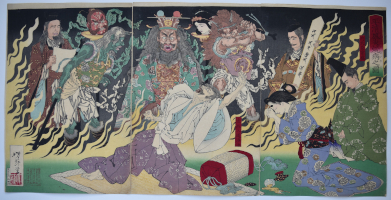
Click here to view image full size.
A triptych Taira Kiyomori hi no yamai no zu, “The Fever of Taira no Kiyomori.” Kiyomori’s wife, Niidono, dreams that the King of Hell, Ema, is coming for Kiyomori for his crime of burning the Rushana Buddha. His family gather around him and pray but to no avail. He dies on the 4/2/1181. Shows Niidono and her son beside a convulsed Kiyomori. Behind are visions of hell with Ema and figures who may have been Kiyomori’s victims. Published by Akiyama Buemon, 1883.
Fine impression, colour and condition. A lovely copy of this triptych. Signed Yoshitoshi ga.
Status: Available
Utagawa KUNIYOSHI (1797-1861)
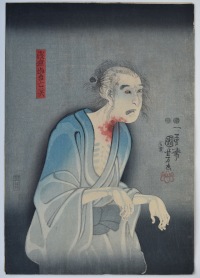
Click here to view image full size.
Ichikawa Kodanji IV as the ghost of Asakura Togo in the play Higashiyama Sakura zoshi, “The Story of Sakura of Higashiyama.” Based on historical events in 1653 with the characters’ names changed (Asakura Togo was actually Sakura Sogoro). The story tells of a village chief who was forced to witness the beheading of his sons before being crucified by the cruel samurai Lord Hotta Kozuki, after he had protested at the levy of unfair taxes. Sakura’s ghost returns to haunt Hotta’s castle. In fact the left sheet of a diptych. However, nearly always sold as a single sheet as the other side does not marry up, is undistinguished and was probably sold separately. Published by Sumiyoshi Masagoro, 1851. Beside the signature is the seal shita-uri, “low sale” meaning it was sold “under the counter” due to censorship laws prevalent at the time. This is the very rare first edition with the carver’s seal Hori Take, Yokokawa Takejiro, to the right of the publisher’s seal on the left. This was removed on later editions. One of the great ghost prints.
Fine impression, colour and condition with gum applied to the eyes (only found on the first edition).Signed Ichiyusai Kuniyoshi ga.
Status: Available
Utagawa HIROSHIGE II (1829-1869)

Click here to view image full size.
An original painting, full colour on silk, 37 x 14 in; 94 x 35.5 cms. The pupil of Hiroshige I who gave him the name Shigenobu. Adopted by Hiroshige in 1845 and married his daughter, Otatsu, on Hiroshige’s death. (Later divorcing her around 1865.) Shows a beauty cooling off on the prow of a boat beneath a full moon and the trestles of a bridge. (Probably the Ohashi over the Sumida River.)
In very good condition and possibly his best painting. Signed Hiroshige ga, seal unread.
Status: Available
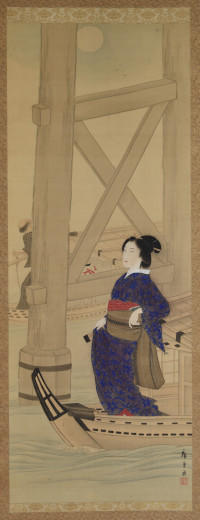
Click here to view image full size.
Yamamoto FUJINOBU (Active 1750-1770)

Click here to view image full size.
An original painting, full colour on paper, image size 32.25 x 7 in; 82 x 18 cms. Shows a parading courtesan with her kamuro. A painter and print artist whose prints were always published by Yamamoto Fusanobu giving rise to the theory that Fujinobu was a pseudonym of the publisher. Much influenced by Harunobu. His prints are extremely rare. Slight creasing, otherwise good condition. Signed Fujinobu ga with indistinct seal.
Status: Available

Click here to view image full size.
Kawanabe KYOSAI (1831-1889)

Click here to view image full size.
A fine original Kyosai painting, full colour on silk, 47.5 x 16.5 in; 121 x 42 cms. Shows Emma, the King of Hell, walking with and holding an umbrella above a courtesan while a ghoulish oni looks on wearing a costume of gunnera leaves. Emma-O is the Japanese Buddhist version of Yama, the Hindu god of death. It was he who assigned people after death to one of the states of reincarnation. He is shown with the headdress, robes and holding the staff of a Chinese judge. The preparatory drawing for this painting is illustrated in Kawanabe Kyosai, In Honour of 100TH Anniversary of His Death, published by Ukiyoe Ota Kinen Bijutsuken, 1989, no. 61, p. 60. Kyosai was a draughtsman of great dexterity with a wild, often bizarre, imagination. Loved sake, sometimes painting under its influence. At an early stage studied under Kuniyoshi, then Maemura Towa and later Kano Chinshin before becoming an independent painter at 27. Adept at highly finished paintings but also produced a large corpus of spontaneous paintings.
In very good condition. Signed Seisai Kyosai with Kyosai seal.
Status: Available
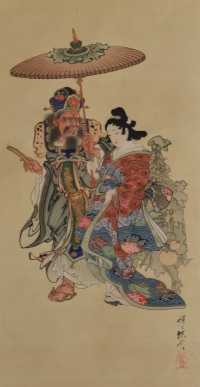
Click here to view image full size.
Utagawa HIROSHIGE (1797-1858)
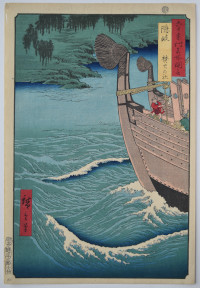
Click here to view image full size.
Oki Province, Takuhi Shrine. From a set of 69 prints [Dai Nihon] Rokujuyoshu meisho zue, “Famous Places in the Sixty-odd Provinces [of Japan]” published by Koshihei between 1853 and 1856, this being 1853. The prows of two boats near the island of Nishinoshima. A torii seen at the top of the print indicates the Takuhi Shrine, one of the most important shrines dedicated to the gods of the sea.
Fine impression and colour. Light album backing, otherwise very good condition. Signed Hiroshige ga.
Status: Available
Utagawa HIROSHIGE (1797-1858)
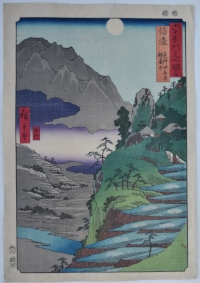
Click here to view image full size.
Shinano, Sarashina tagoto no tsuki, Kyodaisan, “Shinano [Province], the Moon Reflected in the Sarashina Paddy-fields, Mount Kyodai.” This was a popular destination for outings to view the multiple reflections. From a set of 69 prints [Dai Nihon] Rokujuyoshi meisho zue, “Famous Places in the Sixty-odd Provinces [of Japan]” published by Koshimuraya Heisuke between 1853 and 1856, this being 1853.
Fine, early impression. Fine colour and condition with large margins. Signed Hiroshige ga.
Status: Available
Utagawa HIROSHIGE II (1826-1869)
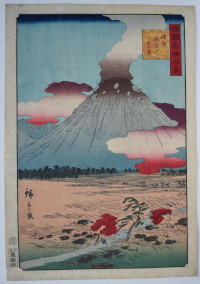
Click here to view image full size.
A view of a smoking Mt Asama, Shinano Province, from Shokoku meisho hyakkei, the “One Hundred Views of Famous Places in the Provinces.” Mt Asama is an active volcano which violently erupted in 1108. Subsequently there was another eruption in 1783 and since then there have been minor tremors. Published by Uoya Eikichi between 1859 and 1861 (this being 1859).
Fine impression, colour and condition. Signed Hiroshige ga.
Status: Available
Toyohara KUNICHIKA (1835-1900)
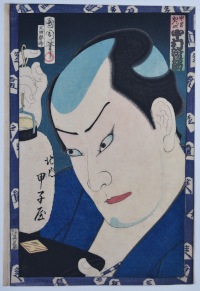
Click here to view image full size.
The actor Nakamura Shikan IV as Ishikawa Hachizaemon in the play Chuko musashi no abumi staged at the Nakamura-za Theatre in 4/1869. From a set of at least 22 prints published by Gusokuya Kahei, 1869. Kunichika was a hack artist who nevertheless produced some fine triptychs (horizontal and vertical) and this fine set of actor bust portaits.
Fine impression and colour. Minor edge soil, otherwise very good condition. Signed Kunichika hitsu.
Status: Available
Shunbaisai HOKUEI (Active 1824-1837)
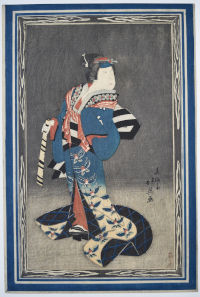
Click here to view image full size.
Shows the actor Arashi Rikan II as the yako Koman holding a shakuhachi and posed within a wooden frame in the play Sugata kurabe deiri no minato, “Comparison of Fighting Figures at the Harbour.” Performed in 1834 at the Naka Theatre, Osaka. A yako was a chivalrous servant, usually of a samurai. Rare: Another impression is in the MIA, acc. no P.75.51.188.
Fine impression with the woodgrain enhanced on the background. Fine colour and condition. Signed Shunbaisai Hokuei ga with the carver’s seal bottom right Kasuke.
Status: Available
Kitagawa UTAMARO II (Fl. c 1807-1830s)
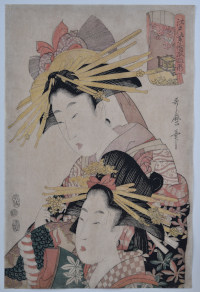
Click here to view image full size.
A courtesan and her Shinzo from a set Edo murasaki edoru hinagata, “Models Designed in the Purple of Edo.” A bluish purple as opposed to the more reddish purple from Kyoto. A pigment that had been extremely expensive and reserved for the elite few, but became cheaper and more accessible during the Edo period, fuelled by leading actors – such as Danjuro – wearing an Edo murasaki headband. Published 11/1807. Publisher unread.
Very good impression, colour and condition. Signed Utamaro hitsu.
Status: Available
Utagawa KUNISADA (1786-1865)
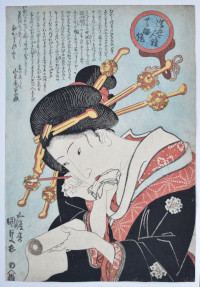
Click here to view image full size.
A courtesan biting on a tissue about to write a love letter from the set Ukiyoe jinsei tengankyo, “Types of the Floating World Seen Through a Physiognomist’s Glass.” The glass top right. These professionals who purported to look at people’s features and give counsel based on their countenance were called Ninsomi or simply Somi. This set of ten prints showing different female personalities have their characteristics written up above. Utamaro produced two fine sets based on this theme in 1792-4 and c 1802: Fuji ninso jupon and Bijin gomenso. The clenching of the tissue is always an indication of arousal. Published c 1830 by Moriya Jihei (Kinshindo).
Fine impression with blind-printing. Fine colour. Small repaired binding holes and very slight trimming, otherwise very good condition. Signed Gototei Kunisada ga.
Status: Available
Kikugawa EIZAN (1787-1867)
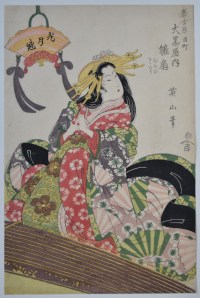
Click here to view image full size.
The geisha Hinaogi of the Daikokuya preparing to play the koto. She is adjusting the tsume (plectra) on her fingers that were used to pluck the strings. The title is enigmatic: It reads Ka getsu kai, “Harbinger of Moon and Flower” and if the character for “moon” is omitted it reads “oiran” (the highest ranking courtesan). Published by Enomotoya Kichibei, c. early 1830s. There is in fact a later copy of this print by Kunisada.
Fine impression. Excellent colour. Very good condition. Signed Eizan hitsu.
Status: Available
Utagawa KUNIYOSHI (1797-1861)
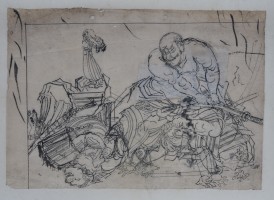
Click here to view image full size.
An original drawing, sumi on thin paper laid onto Japanese paper, 6.5 x 9.25 in; 15.9 x 23.5 cms. A heavily muscled individual (Benkei ?) dispatching two adversaries. Sold “as is” with all imperfections common to surviving drawings. Two areas of pentimenti.
Status: Available
Utagawa KUNISADA (1786-1864)
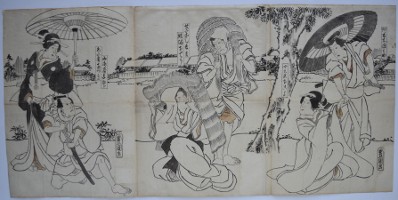
Click here to view image full size.
An original hanshita-e (preparatory drawing) for a triptych showing, from the left, Nakamura Kamenojo I as the geisha Azuma standing above Kawarasaki Gonjuro I as Yamazakiya Yogoro, Bando Kamezo I as Settanaoshi Chogoro standing above Onoe Kikugoro IV as Kumasaka Ocho, and Onoe Kikugoro IV as Akogi Gennojo standing above Onoe Kikujiro II as Onnadayu Okoyo. The play was Yume musubu cho ni torioi performed at the Ichimura-za theatre 3/1856. These first drafts by the artist themselves survive because a more detailed drawing was needed by the blockcutter, and this was normally given to an assistant to execute. Or the drawing was never taken up by the publisher, for whatever reason. Sumi and touches of red with some pentimenti. (This was also most likely a published print by Sanoki as it is from the same group as others offered here.) Signed on two sheets Toyoukuni ga.
Status: Available
Utagawa KUNIYOSHI (1797-1861)
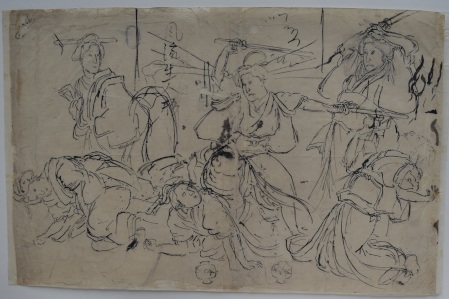
Click here to view image full size.
A fine large original drawing, sumi on thin paper, 12 x 18.5 in; 30.4 x 47 cms. Shows battling women holding what appear to be wooden swords. Two seals at the bottom which appear to be the publisher Honmo who published 1855-56. Provenance: Ex collection Dr. Julius Kurth (1870-1949), an eminent scholar who wrote extensively on Japanese and Chinese art.
Sold “as is” but in good condition.
Status: Available
Tsukioka YOSHITOSHI (1839-1892)
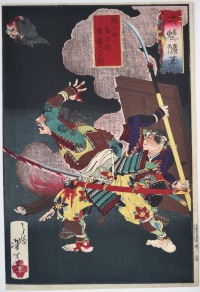
Click here to view image full size.
Shows the bloodied western army commander, Shima Sakon, having severed the head of Sato Daihachi, which flies through the air at Horagatoge Pass. Sakon lead an army of his Lord Ishida Mitsunari against the future Shogun Tokugawa Ieyasu at the battle of Sekigahara in 1600. From the set Ikkai zuihitsu, “Essays by Yoshitoshi.” (Ikkai was an early name of Yoshitoshi’s.) A set of thirteen prints published by Masadaya Heikichi 1872/3. A fine set.
Extremely fine impression and colour from the first edition. (There were no red seals on the first edition of this design.) Trimmed on black border at left, otherwise fine condition. Signed Ikkaisai Yoshitoshi hitsu.
Status: Available
Utagawa YOSHITORA (1836-1887)
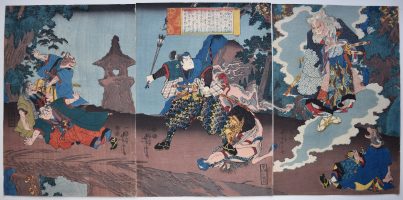
Click here to view image full size.
A triptych showing the warrior Inukai Genpachi (the famous character from the Hakkenden) confronting a cat monster which has emanated from a horse on Mount Koshin. Other cat monsters stare in amazement. Published by Kojimaya Jubei, 1850.
Very fine impression. Fine colour. Imperceptible small binding holes, otherwise fine condition. Signed Ichimosai Yoshitora ga.
Status: Available
Utagawa HIROSHIGE (1797-1858)
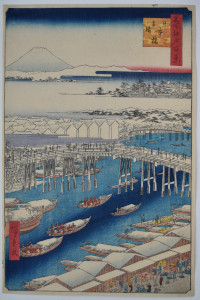
Click here to view image full size.
Nihonbashi yukibare, “The Nihon Bridge, Clear Weather After Snow.” From the set Meisho Edo hyakkei, “One Hundred Views of Edo.” The set published by Uoya Eikichi 1856-58 (this being 1856). The set comprises 118 prints by Hiroshige and another by Hiroshige II. However, three prints are dated 10/1858, the month following Hiroshige’s death and these are thought to be by Hiroshige II as well. They are: Ueno Yamashita, Ichigaya Hachiman and Bikunibashi. Number 1 from the set and a view of the Sumida River with Mt. Fuji in the distance. This is the starting point for the Tokaido Road.
Fine, early impression with gradation on the roofs and on Mt. Fuji. Fine colour. Margins trimmed a little, otherwise very good condition. Signed Hiroshige ga.
Status: Available
Utagawa HIROSHIGE (1797-1858)
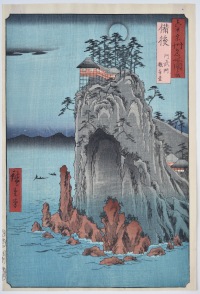
Click here to view image full size.
Bingo, Abuto, Kannondo, “Bingo [Province], Abuto Kannon Temple” from Rokujuyoshu meisho zu, “Famous Views of the Sixty-odd Provinces” published by Koshimuraya Heisuke in 1853-56 (this being 1853). The spectacular position of this small Buddhist temple is at the tip of Cape Abusagi overlooking the Seto Island Sea. This is the first edition with the added cloud top left and extra bokashi. The red signature and title labels are double-printed to give a more saturated colour (also found on early impressions of the Thirty-six Views of Fuji set). Provenance: Purchased from me in 1982.
Fine impression, colour and condition. Signed Hiroshige ga.
Status: Available
Utagawa HIROSHIGE (1797-1858)
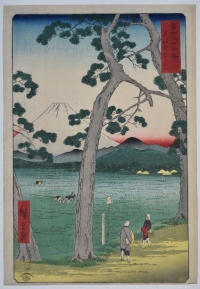
Click here to view image full size.
Tokaido hidari Fuji, “Fuji Seen from the left on the Tokaido [Road]” from Fuji sanjurokkei, “Thirty-six Views of Fuji” published by Tsutaya Kichizo, 1858. Shows travellers on the Tokaido Road at Oiso with workers in rice paddies beyond.
Fine early impression and colour with the red signature and title labels double-printed to give a more saturated colour. Bottom margin trimmed close, otherwise fine condition. Signed Hiroshige ga.
Status: Available
Tsukioka YOSHITOSHI (1839-1892)
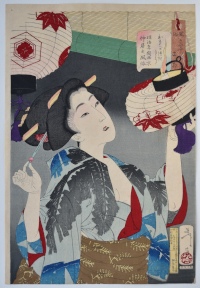
Click here to view image full size.
Okigatsuki-so: Meiji nenken saikyo nakai no fuzoku, “Looking Capable: The Appearance of a Kyoto Waitress in the Meiji Era [1867-1912].” Shows the waitress of a Kyoto geisha house whose job was to act as a go-between for customer and geisha. From a set Thirty-two Aspects of Women published by Tsunashima Kamekichi, 1888. The set depicts women of different backgrounds and occupations from the Kansei era through to the Meiji era with punning allusions to their situation or mood.
Very fine impression of the true first edition. Fine colour and condition. Signed Yoshitoshi ga.
Status: Available
Tsukioka YOSHITOSHI (1839-1892)
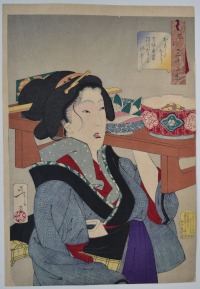
Click here to view image full size.
Omota-so: Tempo nenkan Fukagawa karuko no fuzoku, “Looking Weighed-Down: The Appearance of a Waitress at Fukagawa in the Tempo Era [1830-1844].” Shows the waitress carrying a portable wooden table with food to a geisha party from a set Thirty-two Aspects of Women published by Tsunashima Kamekichi, 1888. The set depicts women of different backgrounds and occupations from the Kansei era through to the Meiji era with punning allusions to their situation or mood.
Very fine impression of the true first edition. Fine colour and condition. Signed Yoshitoshi ga.
Status: Available
Utagawa HIROSHIGE (1797-1858)
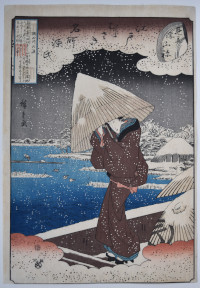
Click here to view image full size.
One of a set: Edo Murasaki meisho Genji, “Murasaki’s Genji in Famous Places of Edo.” Mitate Ukifune Sumidagawa no watashi, “A Parody of Ukifune Crossing the Sumida River.” Shows a beauty on a ferry crossing the Sumida River in heavy snow, representing Ukifune, one of the court ladies of the Genji Monogatari. Stylised clouds above and below copying the traditional kiri-gane gold found on Yamato-e scrolls. These Genji pictures were popular at this time to circumvent the reforms of 1842. Published by Kinseido (his seal also appearing on the umbrella bottom right). Rare.
Fine impression. Very good colour. Lower margin trimmed close, otherwise very good condition. Signed Hiroshige ga.
Status: Available
Utagawa TOYOKUNI I (1769-1825)
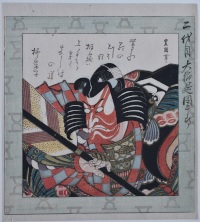
Click here to view image full size.
A surimono showing the actor Ichikawa Danjuro II as Soga no Goro Tokimune holding the giant arrow prior to sharpening it on the large wetstone from the play Yanone Goro. From a series of surimono that paid tribute to the various generations of the Danjuro family. There are two versions of this set of surimono and some ambiguity as to which is the earlier. They are known with blank borders, lacking metallic pigments and signed Ko Toyokuni hitsu (except one design signed Toyokuni II and probably issued in 1833). The other, as here, is signed Toyokuni hitsu, has metallic pigments and the emblem of the Gogawa Poetry Club around the border. The poets were also changed for this issue. It seems that the first version was issued by the Danjuro Fan Club in 1825 and that the reissue, c 1830s, was by the Gogawa. One poem by Ryueishi. The finest design from the set.
Very fine impression with metallic pigments. Fine colour and condition. Signed Toyokuni hitsu.
Status: Available
Utagawa KUNISADA (1786-1864)
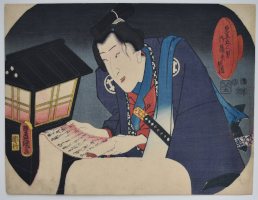
Click here to view image full size.
A fan print showing the actor Bando Shuka I as Shirai Gonpachi from a set Mitate gonin otoko, go-hiiki no omoizashi, “A Parody of the Five Chivalrous Commoners: A Cup of Sake From Their fans.” Omoizashi means to pour sake for one’s loved one and indicates the adoration of the fans for their actors. Published by Yama-Ta, 2/1852.
Very good impression, colour and condition. Signed Toyokuni ga.
Status: Available
Toyohara KUNICHIKA (1835-1900)
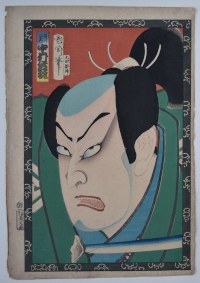
Click here to view image full size.
The actor Nakamura Sagisuke in the role of the samurai attendant Kanji (Chugen Kanji) in the play Kichisama mairu yukari no otozure which was premiered at the Nakamura-za Theatre 15/7/1869. From a set of at least 22 prints published by Gusokuya Kahei, 1869. Kunichika was a hack artist who nevertheless produced some fine triptychs (horizontal and vertical) and this fine set of actor bust portaits.
Fine impression and colour. Slight trimming, otherwise very good condition. Signed Kunichika hitsu.
Status: Available
Toyohara KUNICHIKA (1835-1900)
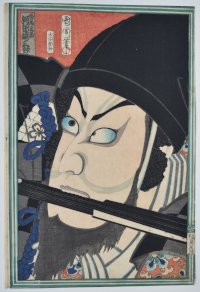
Click here to view image full size.
The actor Kawarasaki Sansho (later Ichikawa Danjuro IX) in the role of Sato Masakiyo in the Momoyama Goten Ohiroma scene from Momoyama Monogatari performed at the Ichimura-za Theatre, 8/1869. From a set of at least 22 prints published by Gusokuya Kahei, 1869. Kunichika produced some fine triptychs (horizontal and vertical) as well as this fine set.
Fine impression and colour. Slightly trimmed, otherwise very good condition. Signed Kunichika hitsu.
Status: Available
Shunkosai HOKUEI (FL. 1829-1837)
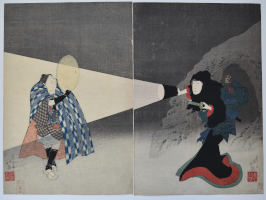
Click here to view image full size.
A dramatic diptych showing the actor Iwai Shijaku I as Lady Osuma shining her lantern on the actor Bando Jutaro as Sasaya Hanbei from the play Honobonoto ura no asagiri, “Daybreak Hidden on the Bay by Morning Fog.” A revenge drama performed at the Naka no Shibai, Osaka, 9/1832. Hanbei is an accomplice of the villain in the play, Karahashi Daisuke. The confrontation takes place immediately after he has murdered the fiancée of the play’s hero, Kowari Dennai, by throwing her off a cliff. He makes his escape by throwing shuriken (star-shaped throwing blades) at Osuma.
Very fine impression. This is a de-luxe edition of the first state “surimono-style.” The hand-stamped block cutter’s seal “surimono cut by Kasuke” bottom left of second sheet. A later edition missing seal was published by Iden. Fine colour with burnished pattern on Osuma’s costume and the poem above is written in metallic pigment. Fine condition. Signed Shunkosai Hokuei ga with seal fumoto no yuki.
Status: Available
Utagawa KUNISADA (1797-1861)
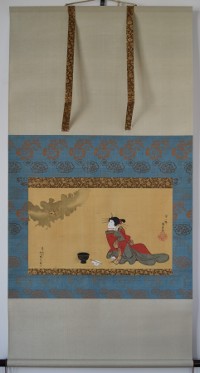
Click here to view image full size.
A fine and interesting original painting, full colour on silk, 11.25 x 20.25 in; 28.5 x 51.5 cms. Shows a reclining beauty looking up at a cuckoo (hototogisu) flying in clouds. The cuckoo is the harbinger of the summer months. This painting, made c 1830, reflects Kunisada’s study, together with Ikkei, of the work of Hanabusa Itcho (1652-1724). Indeed, Ikkei gave Kunisada the name Hanabusa Ittai and this painting is signed Hanabusa Itcho Kunisada ga with seal Hanabusa Ittai Kunisada no in. To the bottom left is an inscription reading “A disciple of Utagawa Kunisada drawn on request [the cuckoo].” There is a small seal but it is undecipherable.
Minor marks but in generally very good condition. Touches of gold and the gofun on the face well retained. Newly mounted with new box.
Status: Available
Hishikawa SORI (Active 1797-1813)

Click here to view image full size.
An original painting, full colour on silk, 43.25 x 14 in; 109.8 x 35.6 cms. An early pupil of Hokusai (who gave him his name Hishikawa Sori in 1798, it previously being Tawaraya). Generally referred to as Sori III. Produced a considerable number of small surimono – some of which can be confused with Hokusai’s work. Shows a beauty with a monkey at her feet. There is a print closely following the painting published in 1906. Illustrated in Nihon ukiyoe hakubutsukan, ed., Nikuhitsu ukiyoe senshu gekan (Selected Painting of Ukiyo-e, second vol.) Tokyo: Gakushu kenkyusha, 1985, plate 193.
In very good condition. Signed Hyakurin Sori ga with seal Sori.
Status: Available
Teisai HOKUBA (1771-1844)
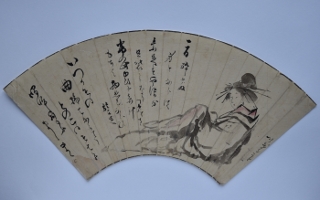
Click here to view image full size.
One of Hokusai’s best pupils. Known for his paintings of beauties but also designed some fine surimono. An original fan painting showing a reclining beauty. Sumi and light red on silvered paper, 7.25 x 17.75 in; 18.5 x 45.2 cms. Removed from a fan, so rib folds and other minor marks. Signed Hokuba ga.
Status: Available
Katsushika HOKUSAI (1760-1849)
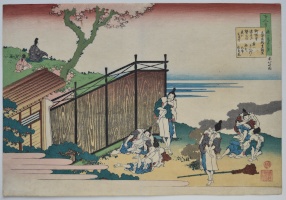
Click here to view image full size.
Hokusai’s interpretation of a poem by Onakatomi no Yoshinobu Ason (921-991). From an unfinished set: Hyakunin isshu uba ga etoki, “Pictures of One Hundred Poems by One Hundred Poets Explained by the Nurse.” The poems are from an anthology Hyakunin isshu, “One Hundred People, One Poem Each” compiled by the poet Fujiwara no Teika (1162-1241). The poet speaks of his love as being like the fire kept by the guards at the gate to the Imperial Palace: It burns hot only at night. There is actually some doubt that the poem can be attributed to Yoshinobu. Shows a group of off-duty Imperial carriage guards relaxing around the smoking embers of a fire. The poet with his servant is seen sitting on the distant hill. Published by Eijudo, 1835-36. A considerable number of original drawings exist for the set that were not turned into prints and are in various museums and private collections.
Fine impression, colour and condition. Signed Saki no Hokusai Manji.
Status: Available
Utagawa HIROSHIGE (1797-1858)
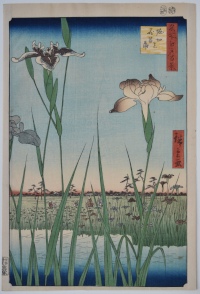
Click here to view image full size.
Horikiri no hana shobu, “Iris Garden at Horikiri” from Meisho Edo hyakkei, “Hundred Famous Views of Edo.” Published by Uoya Eikichi, 1856-58 (this being 1857). Horikiri village on the Arakawa River, north of Edo, was famous for growing irises, chrysanthemums, morning glory and azaleas for the Edo market. One of the most popular prints from the set. Provenance: Purchased from me in 2008.
Fine early impression. Fine colour and condition. Signed Hiroshige ga.
Status: Available
Utagawa HIROSHIGE (1797-1858)
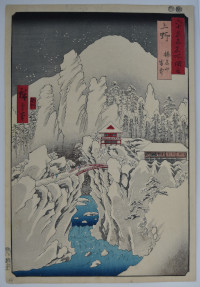
Click here to view image full size.
Kozuke, Harunasan setchu, “Kozuke [Province], Mount Haruna Under Snow.” From a set of 69 prints [Dai Nihon] Rokujuyoshi meisho zue, “Famous Places in the Sixty-odd Provinces [of Japan]” published by Koshihei between 1853 and 1856, this being 1853. A red bridge spans a gorge with precipitous cliffs and a fast flowing river. Fantastic crags point upwards into the sky. In the distance is Mount Haruna – a sleeping volcano.
Very fine impression and colour. Light album backing, otherwise fine condition. Signed Hiroshige ga.
Status: Available
Utagawa KUNIYOSHI (1798-1861)
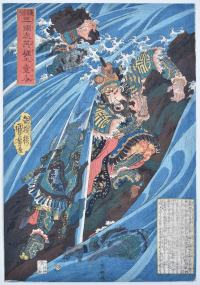
Click here to view image full size.
Cao Cao (Jap. Shuso) and Pang De (Jap. Hotoku) in the Han river during the battle with Guan Yu. From a set of Chinese warrior prints: Tsuzoku sangokushi eiyu no ichinin, “Heroes of the Popular History of the Three Kingdoms.” Published by Joshuya Kinzo, c. 1836. Robinson S10.8 (although only known as a key-block proof). Rare.
Superb impression. Very fine colour and condition. As the day it was printed. Signed Chooro Kuniyoshi ga.
Status: Available
Utagawa KUNIYOSHI (1797-1861)
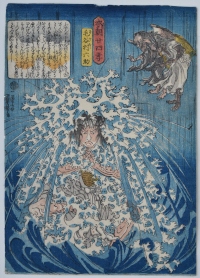
Click here to view image full size.
A fine chuban design showing Keyamura Rokusuke (aka Kida Magobee Muneharu), a famous farmer turned samurai and sumo wrestler of incredible strength, doing penance for seven days under the waterfall at Hikosan Gongen praying for his mother. Two Tengu watch from above. Waterfalls were one of the go-to-places to perform filial piety as they were considered to purify the soul in Shinto/Buddhist culture. From a set Honcho nijushiko, “Twenty-four Paragons of Filial Piety of our Country.” Published by Murataya Tetsu, 1843-6.
Fine impression and colour. Small nick out of top, otherwise very good condition. The signature Ichiyusai Kuniyoshi ga is on the extreme left edge and is often trimmed.
Status: Available
